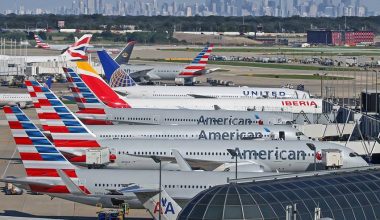Boeing 717, originally conceived as the MD-95, is an ideal short-haul flight aircraft designed for the 100-seat market. Based on the Douglas DC-9 and initially announced as MD-95 at the 1991 Paris Airshow by competitor McDonnell Douglas, the aircraft joined the Boeing product line following Boeing’s acquisition of its long-time rival in 1997.

In contrast to the expectations of most industry observers, the US aerospace giant Boeing decided to keep the production of MD-95s and levied its signature 7×7 naming scheme, rebranding them as Boeing 717s. These vintage workhorses garnered an excellent reputation in economics, performance, and reliability. But their career was short-lived. The aircraft remained in production only for eight years, from 1998 to 2006. Let’s learn more about the short-lived, high-impact career of the Boeing 717.
B717 production and delivery
As soon as Boeing adopted the original MD-95 into its portfolio of products by renaming them Boeing 717, it went ahead with the design and conducted the rigorous flight-test program in September 1998. Awarded the type certification on September 1, 1999, Boeing delivered its first B717 to AirTran Airways on October 12, 1999. Designed for the short-haul, high-frequency passenger airline market, B717 started serving AirTran’s routes like Atlanta-Orlando and Atlanta-Baltimore.
Boeing’s decision to fit rebranded Boeing 717 into its diverse lineup soon started paying off as Trans World Airlines (TWA) ordered 50 B717-200s with an option for 50 more aircraft as a part of its fleet renewal program. The early 717 operators were thrilled with and embraced the reliability and efficiency of these robust workhorses of the skies.
Equipping the best attributes of DC-9, Boeing 717 used advanced technology, which resulted in excellent ‘out of the gate’ reliability, significantly lower operating costs, enhanced flight operations, and improved maintainability. Built for intensive, high-frequency regional operations, the airliner met and exceeded the expectations of its operators on short, regional routes.

However, these extraordinary features were not enough to convince the airlines to place the order for the aircraft, which suffered slow sales. Boeing continued the production of 717s at its Long Beach facility in Southern California till 2006. After rolling the 156th and final B717 off the Assembly line in April 2006 for AirTran Airways, Boeing ceased the production of the type a month later in May.
Why did Boeing stop making the 717?
Despite low maintenance costs, reliable dispatch performance, and superb abilities, the 717s demonstrated poor performance in sales volume and remained in the production line for only eight years. Boeing stopped making the 717 as the type couldn’t hit production and bring profit to the company. Less or more, the failure of B717s can be attributed to the state of the aviation industry in the early 2000s. At the turn of the century, the airline industry faced several turbulences, including the tragic event of 9/11 and skyrocketing fuel prices. Just two years after B717’s roll out to the production line, the slump in airline traffic caused by an economic downturn after the 9/11 terrorist attacks devastated the aviation industry.

American Airlines, which had received B717s as a part of Trans World Airlines acquisition in 2001, sold off all of its 717s as the result of the attack. Many of the 717’s prospective customers scaled back on less known aircraft due to lack of capital or the receding air travel market. Airlines seeking to purchase new aircraft phased out their aging MD fleet favoring more fuel-efficient planes like B737 NG or Airbus A320.
The entry of newer regional jets built by Bombardier and Embraer jets during the early 2000s posed direct competition to B717s and took over the short-haul regional markets. The competition harmed the 717 sales as 50-seat CRJ-200s and ERJ jets were deemed suitable for regional services as they could easily serve routes traditionally operated by turboprops with jets.
In addition to the wrong timing of the 717’s release, the distinctiveness of Boeing 717 from other Boeing product lines also contributed to slow sales of the airliner. Although B717 bore Boeing’s name and its 7×7 scheme, it was not the original product of Boeing and hence didn’t fit well into Boeing’s prolific design family. Airlines were hesitant to purchase an aircraft requiring new crew and maintenance teams; rather, they opted for pre-existing aircraft that already dominated the fleet to maintain the fleet and type commonality.
B717’s meaningful impact over time
Those who operated Boeing 717s were delighted and in awe of the reliability and efficiency of this twin-engine aircraft ideal for short-distance networks. The aircraft incorporated several advanced systems and could cruise at 822km/hr with a range of 2,060 nautical miles. Powered by two Rolls-Royce BR715 turbofan engines, the aircraft comfortably accommodates 106 passengers in a two-class configuration and 117 in a single-class layout.
Marketed as the ‘full-size aircraft for the regional market,’ the 717 is an iconic twin-jet offering from Boeing, primarily serving smaller airports with shorter runways and carrying more passengers than turboprop and other small regional aircraft. The first and last customer of the 717, AirTran Airways, advocated the economics of the airliner having low maintenance costs; just three days for C-check once every 4,500 flying hours.

Impressed with 717’s abilities in 2004, QantasLink-the regional brand of Qantas Airways, announced to replace the fleet of BAe146 aircraft with 115-seat Boeing 717s, which would offer fresher passenger cabins and the extra capacity for the carrier to stimulate growth on regional routes. The carrier hasn’t fallen in love with Boeing 717-200s and still has 20 such units in the fleet. In line with the trend of operating new fuel-efficient and more functional jets, QantasLink will finally retire its 717-200s in 2023 and replace them with the mainline operator’s Airbus A220-300s.
Touted as a commercial failure, Boeing 717 has made a more meaningful impact over time by jumping back into the aviation landscape and proving itself to be valuable in certain unique markets. Out of one-hundred fifty-six 717s produced, 103 are still in service with a handful of airlines. Albeit the availability of new aircraft options, Boeing 717 has held a place in some carriers’ fleets even two decades after it first flew. Who still flies the 717?
Airlines are still flying the 717 aircraft.
More than two decades have passed since the Boeing 717 took to the skies for the first time on September 2, 1998. Several airlines are still flying the 717s in the regional markets owing to their seating configurations, economical fuel efficiency, and remarkable safety record. They include major US-based Delta Air Lines, Australian regional brand QantasLink, and Honolulu-headquartered Hawaiian Airlines.
Boeing 717 Delta
Delta resorts to its pride as the largest operator of the 717, with 64 units in service. Following the merger of Southwest with AirTran, Delta rescaled operation to 717s by entering the agreement with Southwest to lease the entire fleet of 88 jets previously operated by AirTran Airways in 2013.
So, Boeing 717 Delta aircraft are not brand-new jets but used jets that have allowed the carrier to pursue the path to profitability. Instead of buying new planes from Boeing, Delta opted for cheaper used 717s to save money and capitalized on the opportunity of retiring aging DC-9s. Currently, Delta flies nearly 60% of all-in-service 717 jets and plans to keep them through 2030 before eventually replacing them with CS100 jets.
Boeing 717 Qantas
After Delta, in the list of largest operators of 717s comes Qantas, which received the delivery of the aircraft for the first time in 2005. Boeing 717 Qantas joined the carrier fleet to replace BAe 146s as they were faster and had higher dispatch reliability than the latter aircraft. Still thrilled with its durability and reliability, Qantas won’t phase out the humble fleet of B717s until 2023.
Boeing 717 Hawaiian
Like Qantas, Hawaiian Airlines also converted to the 717 plane several years ago but still operates a short-range inter-island network with these workhorses. Hawaiian Airlines has 19 Boeing 717-200s in its fleet, named after birds found in Polynesia. Like the clear safety record of 717s, Hawaiian has never had a fatal accident or hull loss throughout its history.
Is Boeing 717 safe?
Boeing 717 is one of the safest aircraft in the world, proven by its flawless flight record without any fatal crashes. B717 hasn’t recorded a single passenger fatality or hull loss throughout its history throughout its history. But the aircraft has been involved in six aviation accidents and incidents till now, including the latest occurrence reported on July 24, 2022. A Boeing 717-200 Delta was damaged on the ground when the baggage conveyer struck its fuselage at Montreal International Airport.

The major 717 incidents include the 2008 Qantas VH-NXE heavy landing, 2003 attempted hijacking on the Melbourne-Launceston route, and 2001 malfunction of the nose gear extension system causing forced landing on the runway. Thankfully, no deadly crashes have been reported with B717s so far.






